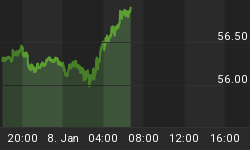Today, we explore the question, "Should I favor stocks or bonds in the coming months?" As we outlined in detail on August 10, inter-market relationships continue to:
- Favor bullish outcomes for stocks.
- Look similar to early stages of risk-on rallies in 2009, 2010, and 2011.
- Highlight risk in bonds.
Before you dismiss the use of charts in investing, we used trend analysis on June 9 to conclude "indicators say be open to stock rally". Since making that bullish argument, the S&P 500 has tacked on 80 points.
On July 7, we noted the Fed has both political and economic cover to launch another round of money-printing, or QE3. Wednesday's tame inflation figures do nothing but increase the odds of QE3 being announced in the coming months. According to Reuters:
U.S. consumer prices were flat in July for a second straight month and the year-over-year increase was the smallest in more than 1-1/2 years, giving the Federal Reserve room to ease policy further to tackle high unemployment.
Before reviewing bullish set-ups, it is always prudent to ask, "What path could the market take to inflict the maximum amount of pain on investors?" We believe the answer is a head-fake pullback, followed by a central bank induced rally to new highs. A pullback would pull in more shorts and cause many longs to sell-out. A move to new highs would then provide maximum frustration for everyone. As shown below, a corrective move back toward 1,385ish to 1,360ish is well within the bounds of a healthy and ongoing uptrend. We will remain bullish as long as the charts remain bullish, be we also respect that countertrend rallies are part of any money-making trend.

The remainder of the analysis in this article is based on the performance of stocks (SPY) relative to bonds (TLT), which can be thought of as the ratio of "risk-on" to "risk-off". When the ratio is rising in the chart below, risk-on is in favor. When the ratio is falling, risk-off has the upper hand. We believe a case can be made that maximum fear relative to the European debt crisis was reached in October of last year. Since last fall, the ratio of risk-on vs. risk-off has made a series of higher lows, which leans bullish (slope of green line below).

A shift in the perception of European "end of the world" risk has taken place over the last eight weeks. The blue trendline below shows risk-off was winning from the ratio's peak in late March 2012 until the bearish trendline was broken in June. The change in risk tolerance was confirmed when the trendline that previously acted as resistance (red arrows) began to act as support (green arrow).

The same chart can be used to show a clear change in the intermediate-term trend from risk-off to risk-on. In terms of forming a new bullish trend, step 1 was the break of the downward-sloping trendline shown below. Step 2 was the ratio made a higher low relative to the May low (see green arrows). Step 3 was completed when the ratio made a higher high in late July (3 is higher than 1). We have a risk-on uptrend in place, which is positive for global stocks (VEU).

At the 8:26 mark of the video below, we cover a potentially bullish set-up on the DeMark exhaustion chart of SPY/TLT (stocks relative to bonds). The signal has not occurred in its present form since October 2004.

After you click play, use the button in the lower-right corner of the video player to view in full-screen mode. Hit Esc to exit full-screen mode. DeMark charts and indicators are proprietary tools of Market Studies, LLC.
Based on technicals and valuations, we have a relatively small stake in China (FXI). Since we made a case for China on July 22, FXI has gained 5.8%. The Shanghai Composite's price-to-earnings (SHCOMP) ratio has dropped to 11.5 from an average of 25 during the past decade and a 2007 high of 46, according to data compiled by Bloomberg. The MSCI Emerging Markets Index (MXEF) is valued at 12 times profit while the Bovespa index in Brazil, the second-biggest emerging market after China, trades for 14.6 times.
The chart below appears to be busy and complex, but the concepts are easy to understand. The chart of risk-on vs. risk-off has an overlay known as Bollinger Bands. You do not need to know anything about Bollinger Bands to see what occurred at the early stages of risk-on rallies in 2009, 2010, and 2011. The blue arrows show where the lower blue band turned up in a bullish fashion. Notice the band has turned up again in 2012 (purple arrow is similar to blue arrows). The green arrows show where the risk-on vs. risk-off ratio crossed the dotted centerline. The red arrow shows a similar bullish centerline cross that is trying to take place this week (the red arrow is similar to the green arrows). After the blue (see 1) and green (see 2) arrows were in place in 2009, 2010, and 2011, stocks rallied for several months (see 3 at bottom of chart). The point is 2012 looks similar to the early stages of stock market rallies in 2009, 2010, and 2011. The signals below become more meaningful if they carry into the end of the week.

Even if 2012 plays out in a similar bullish manner, volatility and countertrend rallies are to be expected. Melt-up rallies in 2009, 2010 and 2011 all experienced multi-week corrections in the early stages of their development. With numerous forms of resistance sitting between 1,400 and 1,415 on the S&P 500, we still have a small hedge (RWM) in place to offset our longs. The markets are vulnerable to a pullback in the short-run, but the longer-term picture still looks positive. Given the valuation picture, we continue to favor foreign stocks (EFA) relative to U.S.-based companies. Greece is one candidate to derail our year-end rally hypothesis.
















